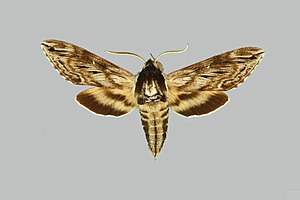Sphinx poecila
| Sphinx poecila | ||||||||||||
|---|---|---|---|---|---|---|---|---|---|---|---|---|

Sphinx poecila , male |
||||||||||||
| Systematics | ||||||||||||
|
||||||||||||
| Scientific name | ||||||||||||
| Sphinx poecila | ||||||||||||
| Stephens , 1828 |
Sphinx Poecila is a butterfly ( moth ) from the family of moth (Sphingidae). The species wasfirst describedby James Francis Stephens in 1828. Grote and Robinson synonymized the species under Sphinx gordius in 1865, until Clark downgradedit to a subspecies, Sphinx gordius borealis, in 1920. It was not until 1980 that Riotte recognized that there were two separate species. The species is the most common hawk in Canada.
features
The moths have a fore wing length of 32 to 43 millimeters. They look very similar to the closely related species Sphinx gordius . This has a much more contrasting pattern than Sphinx poecila , which makes it easy to determine in many cases. The most reliable identification feature, however, is the submarginal area of the forewings, outside the postmedial band, which in Sphinx gordius is very dark, almost black and contrasts clearly with the gray basic color of the rest of the forewing. In Sphinx poecila , this area has the same color as the rest of the wing, only rarely is it powdered black with dark scales at the anal angle . None of the other identifying features mentioned in the literature on the upper sides of the forewings always lead to a correct determination. The type is variable. Most of the individuals are at least slightly darkened, but the black patterns are not variable. The intensity of the white scaling on the forewings is quite variable. There are very light colored animals, but also melanistic forms.
The edge on the outer edge of the forewings is black and white piebald, on the hind wings it is almost completely white and only a little gray. The forewings are dark gray with diffuse black and gray wavy lines and a series of black strokes that end in the wing tip. In addition, a white disk spot is formed. This distinguishes the species from Sphinx canadensis . The hind wings are brownish gray on top with a broad black border and a black median line.
The caterpillars of the two similar species described above are also very similar. Both types have a variable, strong green base color and seven pairs of sloping, white side stripes. In Sphinx gordius , the white stripes are narrow and bordered reddish purple towards the back, whereas the stripes in Sphinx poecila are wide and black or at least very dark. The spiracles are reddish purple in the former species, and rust brown in the Sphinx poecila . The head of Sphinx gordius is green with a pair of dark green vertical stripes, on Sphinx poecila it is dark green with light green stripes. In addition, the caterpillars of Sphinx gordius are quite smooth and the caterpillars of Sphinx poecila below the stigma are strongly provided with secondary bristles. In addition to the green color morph, there is also a light wine-red and one that is a color mixture of the green and wine-red form.
The doll is reddish brown. Your proboscis sheath is exposed. She too looks very much like Sphinx gordius . The Kremaster is a bit wider and doesn't taper as quickly to the double point, which is quite blunt.
Occurrence
It is difficult to map the distribution of this species using older material, as it is not possible to determine which finds actually concern Sphinx gordius . In any case, the species is much more common in the north than its doppelganger. Problems of demarcation exist in the northeastern United States, the region around the Great Lakes and the Canadian Prairie Provinces to the far northeast of Alberta.
Way of life
The moths often fly to light sources at night. Evidence of nectar blossoms is found in Apocynum , Lonicera involucrata , evening primrose ( Oenothera ), common lilac ( Syringa vulgaris ) and phlox ( Phlox ).
Flight and caterpillar times
The moths apparently fly everywhere in their range in one generation from late May to late July.
Food of the caterpillars
The caterpillars feed on a variety of different plants, such as blueberries ( Vaccinium ), East American larch ( Larix laricina ), spear bushes ( Spiraea ) and nail bushes ( Myrica gale ). There are numerous other food plants in the literature, but many of these result from confusion with Sphinx poecila .
development
The females lay their eggs one by one on the leaves of the host plants. The caterpillars are solitary and often diurnal. Pupation takes place in a shallow chamber just below the surface of the earth.
supporting documents
Individual evidence
- ↑ a b c d e f g h i James P. Tuttle: The Hawkmoths of North America, A Natural History Study of the Sphingidae of the United States and Canada. The Wedge Entomological Research Foundation, Washington, DC 2007, ISBN 978-0-9796633-0-7 .
- ↑ Sphingidae of the Americas. Bill Oehlke, accessed December 29, 2011 .
literature
- James P. Tuttle: The Hawkmoths of North America, A Natural History Study of the Sphingidae of the United States and Canada. The Wedge Entomological Research Foundation, Washington, DC 2007, ISBN 978-0-9796633-0-7 .
